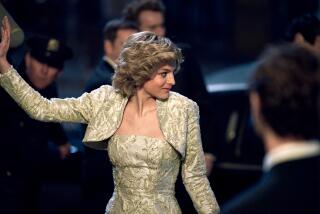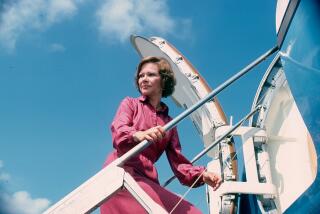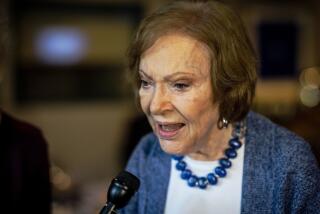Margaret Thatcher dies at 87; Britain’s first female prime minister
- Share via
LONDON -- Margaret Thatcher, the grocer’s daughter who punched through an old-boy political network to become Britain’s first female prime minister, stamping her personality indelibly on the nation and pursuing policies that reverberate decades later, has died. She was 87.
The BBC read out a statement early Monday afternoon from Thatcher’s friend and former advisor, Tim Bell, saying: “It is with great sadness that Mark and Carol Thatcher announce that their mother, Baroness Thatcher, died peacefully following a stroke this morning.”
Prime Minister David Cameron, the current leader of Thatcher’s Conservative Party, said that his country had lost “a great leader, a great prime minister and a great Briton.”
FOR THE RECORD:
Falklands War: An earlier version of this online article incorrectly said Margaret Thatcher ordered the sinking of an Argentine submarine. The vessel was a cruiser, not a submarine.
The woman many regard as Britain’s most important peacetime leader of the 20th century shook her country like an earthquake after moving into 10 Downing St. in 1979. In nearly a dozen years at the top, she transformed the political and economic landscape through a conservative free-market revolution bearing her name, Thatcherism, which sought to reverse Britain’s postwar decline and the welfare state that she felt accelerated it.
VIDEO CHAT: Margaret Thatcher, her life and legacy
Her policies ushered in boom times for go-getter Britons but also exacerbated social inequalities. Such is her legacy that every prime minister since has had to deal with aspects of it, toiling in the shadow of a woman worshiped by her fans and vilified by her foes.
She ended her days as Baroness Thatcher of Kesteven, far removed from her modest birth as Margaret Hilda Roberts of Grantham, a historic market town in northeast England. In between, she accumulated an Oxford education in chemistry, a London law degree, a seat in Parliament and a place in history as the longest continuously serving premier in more than 150 years.
PHOTOS: Margaret Thatcher | 1925 - 2013
The formidable persona she crafted also earned her a string of unflattering nicknames, such as “Attila the Hen” and her best-known moniker, the “Iron Lady.” The latter, from a Soviet newspaper, was meant as an insult. But Thatcher characteristically wore it as a badge of honor, a compliment to her conservative mettle, and it was the inevitable title of a biopic starring Meryl Streep, who won an Oscar in 2012 for her portrayal of a once-fearsome political leader debilitated by Alzheimer’s disease.
Thatcher’s increasing dementia meant infrequent public appearances in recent years, though new prime ministers still stopped by her home to pay their respects and invited her to glittering state occasions. In 2011, she was said to be bitterly disappointed at being too frail to attend an unveiling of a statue of her political soulmate, President Reagan, outside the U.S. Embassy in London.
Like Reagan, Thatcher was a fierce cold warrior. But it was a “hot” conflict that vaulted her into the international spotlight.
In 1982, Argentina invaded the British-ruled Falkland Islands. Caught by surprise, Thatcher launched a military force that recaptured the islands, adorning her leadership with victory laurels and making her a world figure.
At home, she relished a fight as well, pushing through controversial policies that emasculated Britain’s muscular but sometimes dysfunctional trade unions, dismantled elements of the country’s welfare state, auctioned off public services, and encouraged corporate investment and entrepreneurship. Her take-no-prisoners attitude was highlighted by her declaration that Britain’s striking coal miners were “more difficult to fight, but just as dangerous to liberty” as the enemy in the Falklands War.
Thatcherism proved a potent brew of capitalism, patriotism and business-driven individualism that helped Britain throw off its reputation as “the sick man of Europe” -- despite producing mixed results.
A manufacturing economy gradually became a service economy, yet unemployment remained stubbornly high. Privatization spurred many Britons to buy their own homes, but placing public services into private hands eventually led to even higher costs and poorer service, such as a once-renowned train system operated by rival providers. And where some saw a newfound sense of national confidence and ebullience, others saw naked greed and a lack of compassion for those left behind.
Thatcher said of her unyielding methods: “After any major operation, you feel worse before you convalesce, but you don’t refuse the operation when you know that without it you won’t survive.”
No one was unmoved by her. Former French President Francois Mitterrand once said she had “the eyes of Caligula and the mouth of Marilyn Monroe.” In 1999, some Russian admirers formed the “Thatcherite Party of Russia.”
Her polarizing success owed itself not only to her politics but to her personality, that hectoring self-assurance that made her a political juggernaut, part nanny and part Boadicea, Briton’s first-century warrior queen. To say she was not plagued by self-doubt would have been an understatement: William Pile, who worked with her in the early 1970s, said, “She is the only person I know who I don’t think I’ve ever heard say, ‘I wonder whether.’”
Thatcher presented her principles as being as immovable as her lacquered, honey-colored hair. She famously spun the title of a postwar play into her signature line about staying the course: “The lady’s not for turning.”
Her capacity for hard work and little sleep was legendary. In 1984, three years after she refused to concede to imprisoned Irish Republican Army hunger strikers, 10 of whom died, the IRA bombed a Conservative Party convention in the seaside town of Brighton. The blast, which occurred shortly before 3 a.m., ripped through Thatcher’s hotel bathroom, but she was still awake and working on her speech in another room.
The attack killed five of her Tory colleagues. Thatcher insisted that the conference go on.
“She was very macho,” Sir Bernard Ingham, her longtime press secretary, told The Times. “She was absolutely determined to demonstrate that she could beat the men.”
In outlook, gender and class, she was almost as different from many of her fellow Tories as from the opposition Labor Party. Her brisk, assured style rattled the ramparts of the upper-class, Oxbridge-educated, “toffee-nosed” segment of the Conservative establishment, which looked down on the striving middle class from which Thatcher arose.
She was born Oct. 13, 1925, to Beatrice and Alfred Roberts. Her father was a shopkeeper and also the local mayor, rigid in his thrift and moral principles, a reader of Kipling and conservative newspapers.
“I owe almost everything to my father,” Thatcher said, and that included her politics and ambitions.
She won a place at Somerville College, Oxford University, and studied chemistry under future Nobel laureate Dorothy Hodgkin. A short career in science saw her work at a firm that made plastics and another that tested cake fillings, and she was a member of the team that developed soft-serve ice cream.
But politics and Parliament were far more fascinating than test tubes. In 1959, she was elected to the House of Commons, its youngest female member, and swiftly rose in the Conservative ranks. By then, she had married Denis Thatcher, a rich, divorced businessman. They had twins, Carol and Mark, two years later in 1953.
Thatcher was appointed secretary of state for education in 1970, and five years later was elected leader of the Tories, who were then out of power.
She became prime minister in May 1979 when voters booted Labor from power after Britain’s “winter of discontent,” during which a series of strikes left bodies lying unburied in mortuaries and mountains of garbage lying uncollected in the street.
Almost immediately, Thatcher slashed income taxes but raised them on goods and services, a move criticized as shifting the burden down the income ladder.
Some of her fellow Tories were as disgusted as the Labor Party; their old-school noblesse-oblige policies parted company with Thatcher’s more Darwinian politics. And women who had hoped she would be a feminist beacon were also disappointed when Thatcher brought precious few women into her government.
But she knew how to use her gender to good effect.
“I used to say she was absolutely set in her ideology and in her conviction because a man couldn’t get at her in the Gents” -- the men’s bathroom, said Ingham.
Her husband’s support was complete and unwavering, and she returned the favor. One evening, when Thatcher was still a Cabinet member, she hurried out of the office to buy bacon for her husband’s breakfast. When her boss told her there were plenty of people who would be glad to do it for her, she said only she knew how to do it right.
She was conscious of her image, up-marketing her looks and taking elocution lessons to bring down her shrill tones to what the Daily Telegraph called a “fruity contralto.”
She was not consistently socially conservative; she voted to legalize abortion at the same time that she supported capital punishment.
But she was often brutal and belittling toward her own political allies, a propensity that eventually helped lead to her downfall. During one crisis, minister Michael Heseltine stalked out of a Cabinet meeting after shouting at Thatcher: “I hate you, I hate you!”
Her closest political relationship was not with anyone in her own party or even her own country. After her father and her husband, Reagan was the most important man in her life, so much so that the opposition accused her of “always dancing to Reagan’s tune.” In 1986, Thatcher controversially let the Reagan administration use British bases to make bombing runs on Libya.
Reagan reciprocated the loyalty and affection. Her autographed picture sat on the desk of his Century City office after he left the White House. And Thatcher, with typical meticulousness, pre-recorded her eulogy of Reagan after she had experienced some small strokes. At his funeral in 2004, she bowed to his coffin.
Her name also became inextricably linked with Mikhail Gorbachev’s. After meeting the leader who later set the Soviet Union on a path of political and economic reform, Thatcher famously remarked that he was a man “we can do business” with.
The woman who came into office as a novice on foreign matters didn’t hesitate to throw herself into them -- often controversially so, such as her stand against the use of economic sanctions as a way of breaking the back of apartheid in South Africa. Britain’s vexatious relationship with the European Union was a hallmark of her tenure as prime minister, and has bedeviled her successors.
The Falklands War boosted Thatcher’s popularity at home and paved the way for a landslide reelection victory. Even her controversial order to sink an Argentine cruiser, drowning 368 sailors, earned her cheering headlines from nationalistic tabloids and their millions of working-class readers.
Thatcher also held firm during the Persian Gulf War, when she admonished President George H.W. Bush not to “go wobbly” in facing down the Iraqi invasion of Kuwait.
In all, Thatcher led her Conservative Party to three election victories, in 1979, 1983 and 1987. But by the end, her imperious style as prime minister and party leader had sown serious dissent among her Cabinet members and in the parliamentary ranks, and her disastrous experiment with a new kind of local tax, quickly dubbed the “poll tax” because it charged everyone the same amount regardless of income, ignited protests across the country and a riot in the heart of London.
In November 1990, Heseltine decided to run against her on an internal Conservative Party ballot. Thatcher was in Paris when she learned that she had only barely outpolled Heseltine, not by a strong enough margin to be the uncontested leader, in the first round of voting. In spite of her pledge to “fight on -- I fight to win,” she went home to discover that support from her colleagues was crumbling. On Nov. 22, 1990, Thatcher announced that she would step down from the Tory leadership and, hence, from the prime minister’s job.
PHOTOS: Margaret Thatcher | 1925 - 2013
Fighting back tears, she moved out of 10 Downing St. less than a week later.
In her memoirs, she fondly recalled her years at the pinnacle of British politics and the cut-and-thrust of parliamentary debate, when “the adrenaline flows [and] they really come out fighting at me.”
Her husband’s death, in 2003, was a major blow. So was the onset of both mental and physical infirmity.
During Queen Elizabeth II’s golden jubilee service at St. Paul’s Cathedral in 2002, Thatcher’s movements were tentative, though her voice rang out with conviction across the pews. Ten years later, she was too frail to attend a lunch at 10 Downing St. to celebrate the queen’s diamond jubilee.
Hospital visits became more frequent, including a stay over Christmas to have a growth on her bladder removed.
Even as her health weakened, her influence endured. In 2007, a 7 1/2-foot-tall bronze statue of Thatcher -- unveiled, unusually, in her lifetime -- was placed in the House of Commons, opposite that of her fellow Tory leader Winston Churchill. Despite her obvious frailty, Thatcher was on hand for the ceremony.
“I might have preferred iron,” she told a delighted crowd, “but bronze will do.”
More to Read
Start your day right
Sign up for Essential California for the L.A. Times biggest news, features and recommendations in your inbox six days a week.
You may occasionally receive promotional content from the Los Angeles Times.








